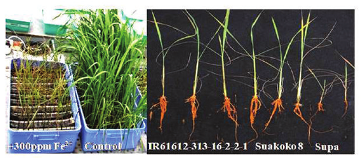Iron (Fe) toxicity can cause leaves bronzing and reduced roots’ oxidation power.
Fe toxicity occurs on a wide range of soils, but generally in low land rice soils with permanent flooding during crop growth.
It can happen through out the growth cycle of the crop.
how to identify (symptoms)
- Tiny brown spots on lower leaves starting from tips and spread towards the leaf base or whole leaf colored orange-yellow to brown.
- Spots combined on leaf interveins and leaves turn orange-brown and die.
- Leaves appear purple-brown if Fe toxicity is severe
- stunted growth and extreamily limited tillering
- damaged root system with a dark-brown to black coating on the root surface and many dead roots
- freshly uprooted rice hills often have poor root systems withmany black roots.

How to manage
Currently there is no practical field management option to treat iron toxicity. Where posible,
- Plant tolerant varieties, by contacting your loacal agriculture office for an upto date list of available varieties
- Apply additional K, Phosporous and Magnesium fertilizers
- Incorporate lime in top soil to raise pH in acid soils
- Carry out mid season drainage to remove accumulated Fe2+, at the mid tillering stage (25-30 days) after planting / sowing.
- Drain the field and keep it free of floodwater ( but moist) for about 7-10 days to improve oxygen supply during tillering


